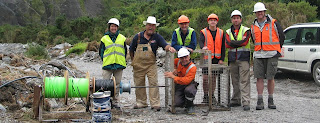 Our project has now moved into completion and demobilisation mode. We drilled boreholes DFDP-1A to 100.6 m and DFDP-1B to 151.4 m. The cores we collected have been carefully packed and taken back to the University of Otago in Dunedin, and the processing tents and most of the people are now also gone.
Our project has now moved into completion and demobilisation mode. We drilled boreholes DFDP-1A to 100.6 m and DFDP-1B to 151.4 m. The cores we collected have been carefully packed and taken back to the University of Otago in Dunedin, and the processing tents and most of the people are now also gone.Wireline logging took several days because of borehole instability issues and yet more technical obstacles. We did not get clear runs through the whole borehole on some of the tools, but we have collected a very nice dataset with a wide range of tools: natural gamma, calliper, electrical resistivity, spontaneous potential, density,
porosity, full waveform sonic, dipmeter, and induction flow meter.
Installation of observatory equipment in borehole DFDP-1B is still under way. We successfully installed a 2 Hz seismometer at the base of the borehole. We have 4 piezometers in place to monitor pore fluid pressure, and will install a fifth tomorrow. Twenty five sensors monitor the average temperature gradient in the borehole and detailed thermal structure immediately above the fault. We will continue with observatory installation and testing tomorrow.
First photo: Full waveform sonic tool and wireline logging truck


Right: Observatory installation team: Jennifer Eccles, Mike Hasting, Simon Cox, myself (kneeling), Alex, John
Townend, and Jeremy Cole-Baker.
An initial observation that I found interesting was confirmation that fault gouge is an effective hydraulic seal. A preliminary estimate of pore pressure difference across the fault in DFDP-1B is equivalent to 33 m of water head. This partly explains borehole instability when the hole was left open: there was a “waterfall” within the borehole trying to wash fractured rocks above the fault into and down the borehole. When trying to clear the borehole in DFDP-1A, to grout a cement-bentonite seal into the fault, we punctured a temporary breach with a long plastic pipe.
There was the most extraordinary slurping noise as water was sucked out of the drill string into the lower pressure gravel aquifer beneath.

Egor lowers casing with a shoe bit and casing advancer inside
Over the next few days we will wind up field operations, demobilise equipment, and secure the permanent observatory. It is gratifying to know that, despite substantial challenges, our long hours, good planning, and excellent contractors have led to success for all of our main technical objectives. We collected lovely cores across the fault, ran a full suite of wireline logs, and installed a fault zone observatory. I specially thank the students involved and our visitors from Liverpool University. Everyone worked long hours and behaved in a very professional and collegial way.
The whole operation was very slick. You really would not have known what a steep learning curve we
had actually all been on. Finally, I give massive thanks to Egor our “senior” driller. He worked hard and long hours, never had a day off, solved the many technical challenges we created for him, and mostly kept a smile on his face too (though he didn’t like torrential rain).
This is Rupert signing out for now. Over following months the massive quantity of samples and data we collected will need to be carefully analysed and written up, so it may take some time before I poke my head up above water again. The next phase, DFDP-2 (>1 km), already has advanced plans, but we will certainly want to improve them now that we have had this practical experience and learnt so much about what we might find at greater depth.
Egor and Alan
Finally, in case you haven't seen it, here is a short introduction to the Alpine Fault Drilling project:

Hi there,
ReplyDeleteIs there any place that we (interested people who aren't involved in the project) can see photos of the core?
Cheers,
This comment has been removed by a blog administrator.
ReplyDeleteNice Blog Thank you for Sharing useful information. For Wire Line Core Barrels visit Focus Mining .
ReplyDeleteThank you for Sharing information about such products Nice Blog. For any of the Exploration Products like Wire Line Core Barrels in Australia & South Africa visit Focus Mining .
ReplyDelete